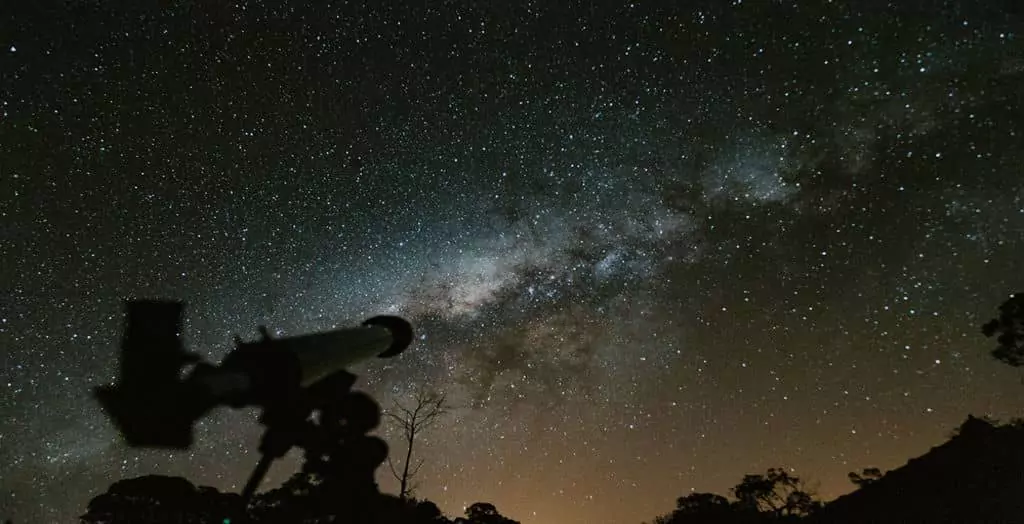Choosing A Telescope For Astrophotography
Are you looking to take excellent pictures of stars and galaxies? That’s what astrophotography is all about! But before you start, you’ll need the right tool: a telescope! This guide will make it easy for you to pick the perfect telescope for taking pictures of the stars. We’ll discuss what to look for, the different types of telescopes, and everything else you need to know. So, get ready to explore the universe and take some fantastic photos!
Gearing Up for Galactic Glory: What to Consider
- BUDGET: When considering purchasing a telescope, it’s crucial to keep your budget in mind. The price range for telescopes varies widely based on their features and quality. Consider how much you’re comfortable spending, as this will guide your choices. Remember, besides the telescope itself, you may need to invest in equipment like cameras and mounts, which can significantly increase the overall cost.
- ASTROPHOTOGRAPHY STYLE: Astrophotography opens up a world of celestial wonders, from distant galaxies to our moon. Imagine the excitement of capturing these objects! Consider what fascinates you: the most faint beauty of galaxies and nebulae or the intricate details of planets and the moon. Your choice of telescope will be your key to these discoveries.
Telescope Features to consider
- APERTURE: This is like the telescope’s light-collecting power. A larger aperture means the telescope can gather more light, which is crucial for seeing faint objects in the sky. However, larger apertures often mean more extensive and heavier telescopes, so consider your portability needs.
- FOCAL LENGTH: The focal length determines the magnification of your telescope and the amount of sky you can see immediately. A shorter focal length is beneficial as it provides a wider field of view. This is particularly useful when capturing large objects such as nebulae. On the other hand, a longer focal length offers more magnification, which is ideal for detailed views of planets and the moon.
- FOCAL RATIO: This is the telescope’s speed. A faster focal ratio means the telescope can capture images more quickly, which is helpful for photographing objects that move across the sky, like planets. However, telescopes with faster focal ratios can be more challenging, especially for beginners.
- MOUNT: Your telescope mount keeps it stable and enables you to follow celestial objects as they travel through the sky. For astrophotography, you’ll want a stable mount that can accurately track the motion of the stars. Equatorial mounts are often preferred for astrophotography because they can easily follow the rotation of the Earth.
Exploring the Telescopic Universe: Different Options
SkyWatcher Explorer 130M: Best Overall (For Beginners with Interest in Astrophotography)
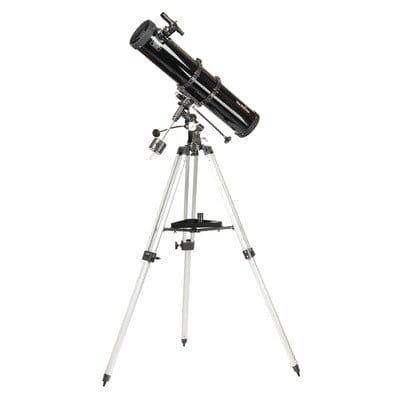
SkyWatcher Explorer 130M
The SkyWatcher Explorer 130M is a Newtonian reflector telescope with a 130mm aperture, ideal for beginners and astronomy enthusiasts alike. This motorized telescope offers good value for its price, allowing you to view the moon, planets, and even some deep-sky objects like nebulae and galaxies.
Pros
- Affordability
- Aperture
- Equatorial mount
- Good for deep sky
- High magnification possible
Cons
- Reflector telescope:
- Open-tube design
- Bulkier than refractor telescopes
The SkyWatcher Explorer 130 M is a top choice for beginners interested in astrophotography. This Newtonian reflector telescope, equipped with a 130mm mirror, offers excellent aperture at an affordable price, making it perfect for capturing faint celestial objects. Its motorized equatorial mount ensures smooth tracking of stars and planets across the night sky, a crucial feature for astrophotography. This telescope is versatile and suitable for visual astronomy and astrophotography additional equipments along. However, it’s worth noting that some models may require polar alignment for optimal performance, which can be a learning curve for beginners.
Specs
| Parameter | Value |
| Optical Design | Newtonian Reflector (Parabolic) |
| Optical Diameter | 130mm |
| Focal Length | 650mm |
| F/Ratio | F/5 |
| Secondary Mirror Diameter | 40mm |
| Highest Practical Power | 260x |
| Finder Scope | Red Dot Finder* |
| Eyepieces | 1.25″ Super 20 and 10* |
Celestron StarSense Explorer: Best for Beginners
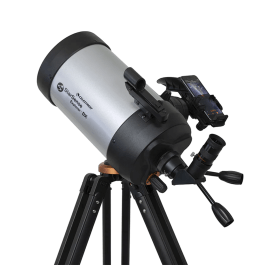
Celestron StarSense Explorer
Celestron StarSense Explorer is a unique telescope designed for beginners. Instead of relying on confusing star charts, it uses your smartphone to identify objects in the night sky. The free StarSense Explorer app analyzes the stars and guides you to point the telescope exactly where you want to look.
Pros
- Accurate star recognition
- Easy to assemble
- StarSense app is intuitive
- Large aperture for brightness
- Good for beginners
- Quality optics
- Red dot finder
- Fun and enjoyable
Cons
- Vibration when adjusting focus
- Mount design causes vibration
- The price point could be lower
- The app has some quirks
The Celestron StarSense Explorer is an excellent choice for beginners. This Newtonian reflector telescope, featuring a 130mm mirror, is paired with an Alt-azimuth mount equipped with StarSense technology. This innovative feature uses your smartphone to simplify locating and aligning the telescope, making it exceptionally user-friendly for newcomers. Its strengths include easy setup and operation, thanks to StarSense technology, a large aperture ideal for capturing faint celestial objects, and affordability for those starting in astrophotography. However, it’s worth noting that Alt-azimuth mounts may require more frequent adjustments during astrophotography sessions than equatorial mounts, and like other Newtonian reflectors, this telescope may introduce coma.
Specs
| Parameter | Value |
| Model Name | StarSense Explorer DX 130 |
| Optical Tube Length | 650 Millimeters |
| Eyepiece Lens | Galilean |
| Objective Lens Diameter | 130 Millimeters |
| Telescope Mount | Altazimuth Mount |
| Product Dimensions | 38.98″D x 16.93″W x 8.98″H |
| Focus Type | Manual Focus |
| Finderscope | Reflex |
| Item Weight | 18 Pounds |
Celestron NexStar 6SE: Best Mid-Range
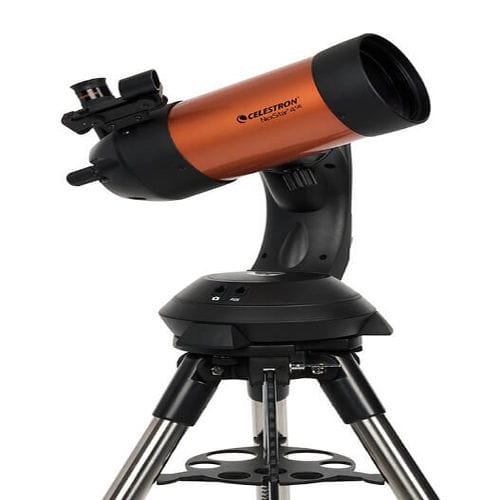
Celestron NexStar 6SE
The Celestron NexStar 6SE is a computerized telescope perfect for both beginners and experienced observers. Its 6-inch primary mirror gathers plenty of light to reveal details on the moon, planets, and even deep sky objects like star clusters and galaxies.
Pros
- Clear images
- Motorized GoTo mount
- Easy to use
- Portable
- Stable tripod
- Detailed views
- Intuitive hand controller
Cons
- Somewhat heavy
- Mishandling during shipping
The Celestron NexStar 6SE is an excellent choice for those seeking a mid-range telescope. Featuring a 6-inch Schmidt-Cassegrain design, this telescope combines mirrors and lenses, providing a compact and easily portable option with a long focal length. Mounted on a computerized GoTo equatorial mount, this telescope offers advanced features, automatically locating and tracking celestial objects to enhance your astrophotography experience. Its strengths include a larger aperture compared to entry-level options, which allows you to capture even fainter celestial details, and its compact and portable design compared to similarly sized Newtonian reflectors, making it ideal for newcomers.
Specs
| Parameter | Value |
| Model Name | Celestron NexStar 6SE |
| Optical Design | Schmidt-Cassegrain |
| Aperture | 6 inches (150mm) |
| Focal Length | 1500mm |
| Focal Ratio | f/10 |
| Mount Type | Computerized Alt-Azimuth GoTo Mount |
| Finderscope | StarPointer Red Dot Finderscope |
| Eyepiece | 25mm |
| Apparent Field of View | 0.83° |
| Total Weight | 30 lbs (13.61 kg) |
Celestron 22203 Astro Fi 130: Best App-Controlled
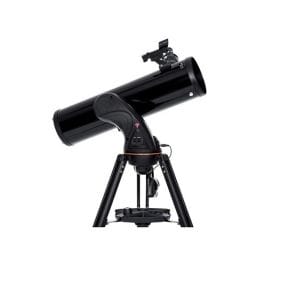
Celestron 22203 Astro Fi 130
The Celestron Astro Fi 130 is a user-friendly, WiFi-enabled telescope ideal for beginners. Control it entirely from your smartphone or tablet using the free Celestron SkyPortal app. This app replaces the traditional hand control, offering a completely wireless observing experience
Pros
- Solid build quality
- Effective WiFi connectivity
- Good for planet viewing
- Easy to use and align
- Lightweight and precise optics
- Convenient cell phone adapter
- Great for viewing galaxies
Cons
- WiFi app dependency
- Short battery life
- Need for stronger eyepieces
- App crashes
The Celestron 22203 Astro Fi 130 is the best option for app-controlled telescopes. Sporting a Newtonian reflector design with a 130mm mirror, it offers impressive clear images. Mounted on a computerized alt-azimuth mount with built-in WiFi and app control, this telescope allows you to effortlessly control and locate celestial objects using your smartphone or tablet. Its strengths lie in its user-friendly app interface, making it particularly suitable for beginners, its large aperture for capturing deep-sky wonders, and its portable design for celestial and terrestrial viewing.
Specs
| Brand | Celestron |
| Model Name | Astro Fi |
| Objective Lens Diameter | 130 Millimeters |
| Telescope Mount Description | Computerized Altitude-Azimuth Single Fork Arm |
| Focus Type | Manual Focus |
| Power Source | Adapter |
| Finderscope | Reflex |
| Item Weight | 17 Pounds |
Celestron AstroMaster 102AZ: Best Budget
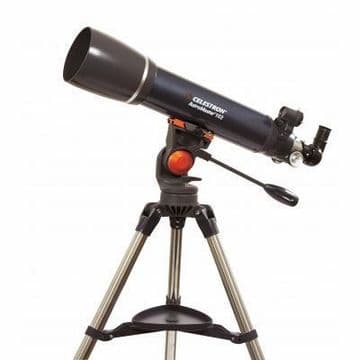
Celestron AstroMaster 102AZ
The Celestron AstroMaster 102AZ is a refractor telescope designed for beginner stargazers. With its easy no-tool setup, you’ll be observing the night sky in minutes. This telescope features a large 4-inch aperture for bright views of the moon, planets, and even some deep-sky objects.
Pros
- Easy setup
- Good value
- Expandable accessories
- Clear view of planets
- Lightweight and portable
- Sturdy build
- Great for beginners
Cons
- Inaccurate finder scope
- Limited vertical movement
The Celestron AstroMaster 102AZ earns its title as the best budget telescope. Featuring a refractor design with a 102mm objective lens, it provides crisp images, particularly ideal for planetary and lunar astrophotography. Mounted on an alt-azimuth mount, this telescope boasts simplicity in setup and operation, though it may require more frequent adjustments during astrophotography compared to equatorial mounts. Its strengths lie in its affordability, making it the most budget-friendly option on this list; its refractor design ensures sharp images suitable for beginners; and its ease of setup and use, perfect for newcomers to astronomy.
Specs
| Model Name | AstroMaster 102AZ |
| Objective Lens Diameter | 102 Millimeters |
| Telescope Mount Description | Altazimuth Mount |
| Focus Type | Manual Focus |
| Finderscope | Reflex |
| Item Weight | 1100 Grams |
| Number of Batteries | 1 CR2032 battery required (included) |
| Lens Coating Description | Fully Coated |
Beyond the Telescope: Additional Gear
Now that you’ve picked out your telescope, let’s discuss some additional gear you’ll need for astrophotography:
- Camera: A DSLR camera with interchangeable lenses is perfect for capturing stunning celestial images. Make sure it offers manual control over settings like shutter speed, aperture, and ISO. Some mirrorless cameras also work well for astrophotography.
- Tripod: Stability is vital for clear, sharp images. Consider purchasing a strong and durable tripod with a dependable head that can handle the weight of your camera and telescope arrangement. This will prevent unwanted blurring during long exposures.
- Intervalometer: You’ll want an intervalometer to automate your shooting process and capture multiple exposures. This handy device triggers your camera at specified intervals, allowing you to stack images later for enhanced clarity and detail in your final photos.
Sharpening Your Skills: A Few Astrophotography Tips
Astrophotography is an art that rewards dedication and patience. Here are some quick tips to help you capture stunning celestial images:
- Seek out dark skies: Light pollution can dim the brilliance of your photos. Find a location away from city lights to ensure more transparent, more vibrant images.
- Learn the basics: Understanding exposure, aperture, ISO, and image stacking can vastly improve your results. Explore online tutorials and resources to grasp these fundamental techniques.
- Practice makes perfect: Take your time with initial challenges. With practice, you’ll gain confidence in handling your equipment and refining your astrophotography skills.
- Connect with fellow enthusiasts: Joining online forums or local astronomy clubs can provide invaluable support and knowledge-sharing opportunities. Engage with the astrophotography community to exchange tips, ask questions, and draw inspiration from others’ experiences.
Conclusion:
The selection of a telescope for astrophotography marks the beginning of an exciting journey. What matters most is your passion for the night sky. With the correct telescope, some additional tools, and a willingness to learn, you are certain to go on a thrilling quest to capture the breathtaking magnificence of the universe and share it with others. Have you ever tried astrophotography before? Share your experiences and any tips you have for beginners in the comments!
FAQs
What is the best telescope for astrophotography?
There is no one answer to this question, as the best telescope for astrophotography will depend on your budget, experience level, and the types of objects you want to photograph.
What other equipment do I need for astrophotography?
In addition to a telescope, you will also need a camera, a telescope mount, and a t-ring adapter to connect your camera to the telescope. Consider using a star tracker, which can help improve your telescope mount’s tracking accuracy.
How important is polar alignment?
Polar alignment is essential for astrophotography. It is aligning your telescope mount with the Earth’s North Pole. This will help to ensure that your telescope tracks the stars accurately.
What are some excellent resources for learning more about astrophotography?
Many resources are available online and offline in libraries that can teach you more about astrophotography.

